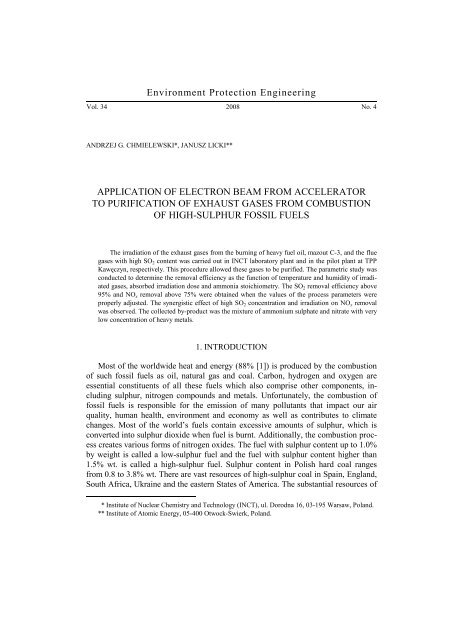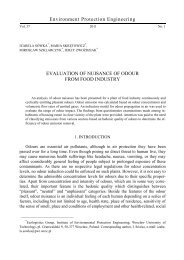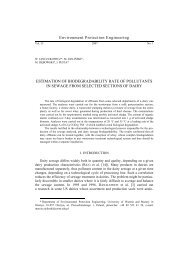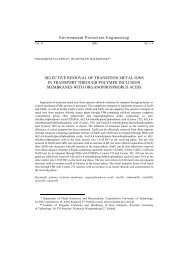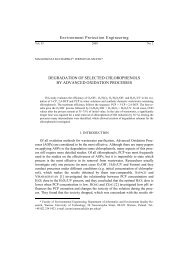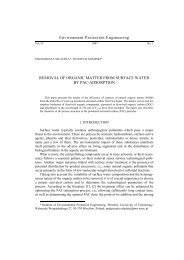Application of electron beam from accelerator to purification of ...
Application of electron beam from accelerator to purification of ...
Application of electron beam from accelerator to purification of ...
Create successful ePaper yourself
Turn your PDF publications into a flip-book with our unique Google optimized e-Paper software.
Environment Protection Engineering<br />
Vol. 34 2008 No. 4<br />
ANDRZEJ G. CHMIELEWSKI*, JANUSZ LICKI**<br />
APPLICATION OF ELECTRON BEAM FROM ACCELERATOR<br />
TO PURIFICATION OF EXHAUST GASES FROM COMBUSTION<br />
OF HIGH-SULPHUR FOSSIL FUELS<br />
The irradiation <strong>of</strong> the exhaust gases <strong>from</strong> the burning <strong>of</strong> heavy fuel oil, mazout C-3, and the flue<br />
gases with high SO 2 content was carried out in INCT labora<strong>to</strong>ry plant and in the pilot plant at TPP<br />
Kawęczyn, respectively. This procedure allowed these gases <strong>to</strong> be purified. The parametric study was<br />
conducted <strong>to</strong> determine the removal efficiency as the function <strong>of</strong> temperature and humidity <strong>of</strong> irradiated<br />
gases, absorbed irradiation dose and ammonia s<strong>to</strong>ichiometry. The SO 2 removal efficiency above<br />
95% and NO x removal above 75% were obtained when the values <strong>of</strong> the process parameters were<br />
properly adjusted. The synergistic effect <strong>of</strong> high SO 2 concentration and irradiation on NO x removal<br />
was observed. The collected by-product was the mixture <strong>of</strong> ammonium sulphate and nitrate with very<br />
low concentration <strong>of</strong> heavy metals.<br />
1. INTRODUCTION<br />
Most <strong>of</strong> the worldwide heat and energy (88% [1]) is produced by the combustion<br />
<strong>of</strong> such fossil fuels as oil, natural gas and coal. Carbon, hydrogen and oxygen are<br />
essential constituents <strong>of</strong> all these fuels which also comprise other components, including<br />
sulphur, nitrogen compounds and metals. Unfortunately, the combustion <strong>of</strong><br />
fossil fuels is responsible for the emission <strong>of</strong> many pollutants that impact our air<br />
quality, human health, environment and economy as well as contributes <strong>to</strong> climate<br />
changes. Most <strong>of</strong> the world’s fuels contain excessive amounts <strong>of</strong> sulphur, which is<br />
converted in<strong>to</strong> sulphur dioxide when fuel is burnt. Additionally, the combustion process<br />
creates various forms <strong>of</strong> nitrogen oxides. The fuel with sulphur content up <strong>to</strong> 1.0%<br />
by weight is called a low-sulphur fuel and the fuel with sulphur content higher than<br />
1.5% wt. is called a high-sulphur fuel. Sulphur content in Polish hard coal ranges<br />
<strong>from</strong> 0.8 <strong>to</strong> 3.8% wt. There are vast resources <strong>of</strong> high-sulphur coal in Spain, England,<br />
South Africa, Ukraine and the eastern States <strong>of</strong> America. The substantial resources <strong>of</strong><br />
* Institute <strong>of</strong> Nuclear Chemistry and Technology (INCT), ul. Dorodna 16, 03-195 Warsaw, Poland.<br />
** Institute <strong>of</strong> A<strong>to</strong>mic Energy, 05-400 Otwock-Świerk, Poland.
52<br />
A.G. CHMIELEWSKI, J. LICKI<br />
lignite with the sulphur content higher than 2.5% wt. are found in the Maritza-East<br />
Region (Bulgaria) where big thermal power plants (TPPs) are installed. Heavy fuel<br />
oils (HFO) are the mixture <strong>of</strong> hydrocarbons composed <strong>of</strong> residual fractions <strong>from</strong> distillation<br />
and processing <strong>of</strong> crude oil. HFO is essentially an industrial fuel being suitable<br />
for use in thermal power plants, refineries, industrial boilers, pulp and paper industry,<br />
marine applications and metallurgical operations, which generally preheat the<br />
fuel oils. Depending on the source, the sulphur content in the HFO could be as high as<br />
4% wt. Flue gas emitted as a result <strong>of</strong> combustion <strong>of</strong> high-sulphur fuel contains high<br />
SO2 and NOx concentrations, many times exceeding the permissible emission limits,<br />
which necessitates the use <strong>of</strong> add-on control device for the reduction <strong>of</strong> SO2 and NOx<br />
emissions. The study <strong>of</strong> the application <strong>of</strong> <strong>electron</strong> <strong>beam</strong> flue gas treatment (EBFGT)<br />
process <strong>to</strong> the <strong>purification</strong> <strong>of</strong> such flue gas was the task <strong>of</strong> this paper.<br />
2. STATUS OF ELECTRON BEAM FLUE<br />
GAS TREATMENT TECHNOLOGY<br />
The EBFGT technology is among the promising advanced technologies <strong>of</strong> new the<br />
generation. It is a dry-scrubbing process <strong>of</strong> simultaneous SO2 and NOx removal, where<br />
no waste is generated. In this technology, the temperature and humidity <strong>of</strong> flue gas are<br />
modified in the spray cooler, then almost s<strong>to</strong>ichiometric amount <strong>of</strong> ammonia is added<br />
<strong>to</strong> the flue gas and such a gas mixture is irradiated in the process vessel by the <strong>electron</strong><br />
<strong>beam</strong> <strong>from</strong> <strong>accelera<strong>to</strong>r</strong>. The by-product is collected by the electrostatic precipita<strong>to</strong>r<br />
(ESP) and may be used as an agricultural fertilizer or as a component <strong>of</strong> NPK or<br />
NPKS commercial fertilizer. This technology was implemented in a full-industrial<br />
scale at the Electric Power Station (EPS) “Pomorzany” in Szczecin for <strong>purification</strong> <strong>of</strong><br />
flue gases emitted <strong>from</strong> two low-sulphur coal-fired Benson boilers. In this industrial<br />
3<br />
m n /h, SO2 and NOx are removed <strong>from</strong> flue<br />
plant with a nominal flow rate <strong>of</strong> 270 000<br />
gas with the efficiency exceeding 90% and 70%, respectively [2].<br />
3. RADIATION TREATMENT OF EXHAUST GASES EMITTED DURING<br />
COMBUSTION OF HIGH-SULPHUR FUELS<br />
The applicability <strong>of</strong> EBFGT technology <strong>to</strong> <strong>purification</strong> <strong>of</strong> flue gas produced during<br />
combustion <strong>of</strong> high-sulphur fuels was tested at two plants.<br />
3.1. PILOT PLANT AT THERMAL POWER PLANT “KAWĘCZYN”<br />
The pilot plant built at TPP “Kawęczyn” is designed for <strong>electron</strong> <strong>beam</strong> irradiation<br />
<strong>of</strong> flue gases emitted <strong>from</strong> coal-fired boiler WP-120 (figure 1) [3].
<strong>Application</strong> <strong>of</strong> <strong>electron</strong> <strong>beam</strong> <strong>from</strong> <strong>accelera<strong>to</strong>r</strong> <strong>to</strong> <strong>purification</strong> <strong>of</strong> exhaust gases 53<br />
Fig. 1. Schematic flow diagram <strong>of</strong> pilot plant at TPP “Kawęczyn”<br />
The hard coal with the sulphur content <strong>of</strong> about 0.7% wt. was burnt in a boiler and<br />
SO2 concentration in the flue gas approximated <strong>to</strong> 500 ppmv. At the pilot plant inlet,<br />
the gaseous SO2 <strong>from</strong> cylinder was added in a sufficient quantity <strong>to</strong> the flue gas <strong>to</strong><br />
increase its SO2 concentration up <strong>to</strong> 3200 ppmv. The flue gas with high SO2 concentration<br />
simulates an exhaust gas emitted during combustion <strong>of</strong> high-sulphur coal. The<br />
study was carried out at the flow rate <strong>of</strong> 10 000<br />
3<br />
m n /h <strong>of</strong> flue gas irradiated in the<br />
process vessel (PV) by the <strong>electron</strong> <strong>beam</strong> emitted <strong>from</strong> two ELV-3A <strong>accelera<strong>to</strong>r</strong>s<br />
(two-stage irradiation).<br />
3.2. LABORATORY PLANT AT INSTITUTE OF NUCLEAR<br />
CHEMISTRY AND TECHNOLOGY (INCT)<br />
The labora<strong>to</strong>ry plant built at INCT [3] was adapted <strong>to</strong> the burning <strong>of</strong> heavy fuel oil<br />
mazout C-3 with sulphur content <strong>of</strong> about 3 % wt. (figure 2).<br />
The natural flue gas was irradiated in the process vessel by the <strong>electron</strong> <strong>beam</strong><br />
emitted <strong>from</strong> ILU-6M <strong>accelera<strong>to</strong>r</strong> (one-stage irradiation).
54<br />
A.G. CHMIELEWSKI, J. LICKI<br />
Fig. 2. Schematic diagram <strong>of</strong> labora<strong>to</strong>ry plant at INCT for the treatment<br />
<strong>of</strong> flue gas <strong>from</strong> burning <strong>of</strong> high-sulphur heavy fuel oil:<br />
1 – thermostated fuel oil, 9 – <strong>electron</strong> <strong>beam</strong> <strong>accelera<strong>to</strong>r</strong>,<br />
2 – oil burner, 10 – retention chamber,<br />
3 – particulate and soot filters, 11 – bag filter,<br />
4 – orifice, 12 – gas sampling point – process outlet,<br />
5 – dosage <strong>of</strong> water vapour, 13 – induced-draught fan,<br />
6 – gas sampling point – process inlet, 14 – stack,<br />
7 – ammonia injection, 15 – concrete shielding wall,<br />
8 – process vessel, 16 – concrete shielding door<br />
3.3. ANALYTICAL SYSTEM<br />
The reliable and precise measurements <strong>of</strong> flue gas parameters in the crucial points<br />
<strong>of</strong> the plant are necessary for its proper operation and control. Figure 1 schematically<br />
depicts the places where these measurements were carried out. Two independent extraction<br />
multi-gas systems were installed <strong>to</strong> moni<strong>to</strong>r the relevant constituents <strong>of</strong> the<br />
flue gas; one at the process inlet labelled with System-1 (upstream <strong>of</strong> the spray cooler)<br />
and the other at the process outlet labelled with System-2 (downstream <strong>of</strong> the ESP or<br />
bag filter). Each system consists <strong>of</strong>:<br />
– SO2 analyzer, Model 40, pulsed fluorescent.<br />
– NO/NOx analyzer, Model 10A/R, chemiluminescent.<br />
– Model 900 for heated sample gas conditioning and dilution. Dilution ratio 20:1.<br />
At the process outlet (System-2), the concentration <strong>of</strong> unreacted ammonia was<br />
determined by chemiluminescent analyzer, Model 17C, with two converters. All these
<strong>Application</strong> <strong>of</strong> <strong>electron</strong> <strong>beam</strong> <strong>from</strong> <strong>accelera<strong>to</strong>r</strong> <strong>to</strong> <strong>purification</strong> <strong>of</strong> exhaust gases 55<br />
gas analyzers were manufactured by Thermo Environmental Instrument Co. (TEI<br />
<strong>from</strong> USA). Analyzer readings for SO2, NO/NOx and NH3 were verified using manual<br />
analytical methods (grab sample system). The by-product was also analyzed <strong>to</strong> evaluate<br />
its salability as an agricultural fertilizer. An ionic analysis was used yielding the<br />
amount <strong>of</strong> sulfate, nitrate and ammonium ions along with water and insoluble content.<br />
4. RESULT AND DISCUSSION<br />
In the previous studies <strong>of</strong> this technology, it was demonstrated that the efficiencies<br />
<strong>of</strong> SO2 and NOx removal depend on the following process parameters: an absorbed dose<br />
(D) <strong>of</strong> irradiation, ammonia s<strong>to</strong>ichiometry α , gas temperature at the inlet <strong>to</strong> the pro-<br />
cess vessel (TinletPV), gas humidity (H) and inlet NOx concentration (NO )<br />
0<br />
x . The parametric<br />
studies <strong>of</strong> SO2 and NOx removal efficiency were performed at both plants.<br />
NH<br />
4.1. EFFECT OF ABSORBED DOSE<br />
Figure 3 presents the dependence <strong>of</strong> the irradiation dose on SO2 and NOx removal<br />
efficiency.<br />
Fig. 3. Effect <strong>of</strong> absorbed dose on efficiencies <strong>of</strong> SO 2 and NO x<br />
removal <strong>from</strong> flue gas obtained <strong>from</strong> burning <strong>of</strong> heavy-fuel oil, mazout C-3<br />
The absorbed dose is the primary fac<strong>to</strong>r influencing NOx removal efficiency. The<br />
process starts at zero efficiency for zero dose and indicates saturation at high doses.<br />
3
56<br />
A.G. CHMIELEWSKI, J. LICKI<br />
This proves that NOx removal is a radiation-induced process. A higher absorbed dose<br />
induces higher NOx removal. The SO2 removal is based on two different pathways:<br />
thermal process and radiation-induced process. At zero dose, SO2 removal is governed<br />
by thermal reaction <strong>of</strong> SO2 and NH3 in moist environment. This reaction takes place<br />
in the gaseous phase as well as on the surfaces such as those on the filter cake <strong>of</strong> bag<br />
filter. Sulphur dioxide removal increases sharply with an increase <strong>of</strong> irradiation dose<br />
up <strong>to</strong> 8 kGy and then flattens out at high doses.<br />
4.2. EFFECT OF AMMONIA STOICHIOMETRY<br />
The efficiency SO2 removal increases markedly with the increase <strong>of</strong> ammonia<br />
concentration in the irradiated flue gas. Above α = 0.9 this increase is gradual.<br />
The efficiency <strong>of</strong> NOx removal slightly increases with ammonia addition. Fractions <strong>of</strong><br />
the ammonia added remain unreactive and exist in the plant outlet (the so-called ammonia<br />
slip). In practice, it is desirable <strong>to</strong> keep the ammonia slip concentration as low<br />
as possible due <strong>to</strong> its harmful effect on environment. In the experiments performed at<br />
the pilot plant at TPP “Kawęczyn”, the optimum ammonia s<strong>to</strong>ichiometry should be<br />
about 0.9. In this case, the optimum efficiency <strong>of</strong> removal is obtained for both pollutants,<br />
as well as for slight ammonia slip (lower than 10 ppmv).<br />
NH3<br />
4.3. EFFECT OF GAS TEMPERATURE AT INLET TO PROCESS VESSEL<br />
Figure 4 presents the effect <strong>of</strong> gas temperature on the efficiency <strong>of</strong> SO2 and NOx<br />
removal.<br />
Fig. 4. Effect <strong>of</strong> gas temperature on efficiencies <strong>of</strong> NO x and SO 2 removal
<strong>Application</strong> <strong>of</strong> <strong>electron</strong> <strong>beam</strong> <strong>from</strong> <strong>accelera<strong>to</strong>r</strong> <strong>to</strong> <strong>purification</strong> <strong>of</strong> exhaust gases 57<br />
The efficiency <strong>of</strong> SO2 removal significantly increases with the drop in gas temperature.<br />
This is in contrast with NOx removal, which increases with the increase <strong>of</strong><br />
gas temperature. Gas temperature has a significant impact on the SO2 removal and<br />
small effect on the efficiency NOx removal. This indicates that flue gas temperature at<br />
the inlet <strong>to</strong> process vessel can be effectively used <strong>to</strong> change SO2 removal efficiency<br />
with a minimal impact on the NOx removal. In the case <strong>of</strong> flue gas with high SO2 concentration,<br />
it is necessary <strong>to</strong> select low gas temperature in the range <strong>of</strong> 60–70 ºC <strong>to</strong><br />
obtain high efficiency <strong>of</strong> SO2 removal.<br />
4.4. EFFECT OF FLUE GAS HUMIDITY<br />
The efficiency <strong>of</strong> SO2 removal increases markedly with the increase <strong>of</strong> moisture<br />
content. This increase is due <strong>to</strong> exothermic reaction between ammonia and SO2, without<br />
irradiation. On the other hand, the moisture content does not affect the removal <strong>of</strong><br />
NOx. The optimum efficiency <strong>of</strong> the removal <strong>of</strong> both pollutants is obtained at gas humidity<br />
greater than 11% vol.<br />
4.5. EFFECT OF INLET HIGH SO 2 CONCENTRATION<br />
Figure 5 presents the effect <strong>of</strong> high inlet SO2 concentration on the efficiency <strong>of</strong><br />
NOx removal.<br />
Fig. 5. Effect <strong>of</strong> inlet high SO 2 concentration on efficiency <strong>of</strong> NO x removal
58<br />
A.G. CHMIELEWSKI, J. LICKI<br />
At a given dose (11.5 kGy in figure 5) a definite improvement <strong>of</strong> NOx removal<br />
with an increase <strong>of</strong> high SO2 concentration was observed. This synergistic effect <strong>of</strong><br />
high SO2 concentration is explained by the following radiation-induced reaction<br />
cycle [4]:<br />
In the second reaction, the<br />
•<br />
SO2 + OH<br />
+ M → HSO3 + M,<br />
HSO3 + O2 → SO3 +<br />
NO +<br />
•<br />
NO2 + OH<br />
•<br />
2<br />
•<br />
HO 2 ,<br />
HO → NO2 + OH ,<br />
+ M → HNO3 + M.<br />
•<br />
•<br />
HO 2 radicals are formed, which efficiently oxidize NO<br />
•<br />
and regenerate the previously depleted OH radicals. Thus the SO2 oxidation promotes<br />
the NOx oxidation by generating additional oxidizing radicals. Therefore the<br />
energy consumption <strong>of</strong> the process is lower for high-sulphur flue gas.<br />
5. CONCLUSIONS<br />
Flue gases <strong>from</strong> combustion <strong>of</strong> high-sulphur fossil fuels can be effectively purified<br />
by their irradiation with an <strong>electron</strong> <strong>beam</strong>. The removal efficiencies <strong>of</strong> SO2 and<br />
NOx exceeding 95% and 75%, respectively, were obtained under the optimum<br />
treatment conditions. These efficiencies can be obtained, first <strong>of</strong> all, by a proper<br />
controlling <strong>of</strong> the temperature and humidity <strong>of</strong> flue gas in a dry bot<strong>to</strong>m spray<br />
cooler. Then a near s<strong>to</strong>ichiometric amount <strong>of</strong> NH3 should be added <strong>to</strong> gas before its<br />
entering the inlet <strong>of</strong> a process vessel. Next, the mixture should be irradiated with an<br />
adequate irradiation dose in a process vessel. The improvement in NOx removal is<br />
achieved by multi-stage irradiation and by an adequate dose distribution between<br />
irradiation stages [5]. The gas humidity and temperature, ammonia s<strong>to</strong>ichiometry<br />
and irradiation dose up <strong>to</strong> 8 kGy strongly influence the efficiency <strong>of</strong> SO2 removal.<br />
The synergistic effect <strong>of</strong> high SO2 concentration and irradiation on NOx removal<br />
was indicated. The collected by-product was the mixture <strong>of</strong> ammonium sulphate<br />
and nitrate. The content <strong>of</strong> heavy metals in the by-product was many times lower<br />
than that acceptable for commercial fertilizer.<br />
ACKNOWLEDGEMENTS<br />
The paper was supported by the Polish Ministry <strong>of</strong> Science and High Education – project No. PBZ-<br />
MEN-3/2/2006: Process engineering for the abatement <strong>of</strong> harmful and greenhouse gas emissions and<br />
their utilization.
<strong>Application</strong> <strong>of</strong> <strong>electron</strong> <strong>beam</strong> <strong>from</strong> <strong>accelera<strong>to</strong>r</strong> <strong>to</strong> <strong>purification</strong> <strong>of</strong> exhaust gases 59<br />
REFERENCES<br />
[1] BAUKAL Ch.E., Industrial combustion pollution and control, Marcel Dekker, Inc, New York–Basel,<br />
2004.<br />
[2] CHMIELEWSKI A.G., LICKI J., PAWELEC A., TYMIŃSKI B., ZIMEK Z., Operational experience <strong>of</strong> the<br />
industrial plant for <strong>electron</strong> <strong>beam</strong> flue gas treatment, Radiat. Phys. Chem., 2004, 71, 1–2, 441–444.<br />
[3] CHMIELEWSKI A.G., ILLER E., ZIMEK Z., LICKI J., Labora<strong>to</strong>ry and industrial research installations for<br />
<strong>electron</strong> <strong>beam</strong> flue gas treatment, IAEA-SM-325/124, Vienna, 1992.<br />
[4] PAUR H.R., Electron <strong>beam</strong> scrubbing for high sulphur flue gas, [in:] Modern Problems <strong>of</strong> Electrostatics<br />
with <strong>Application</strong>s in Environment Protection, I.I. Inculet et al. (eds.), Kluwer Academic Publishers,<br />
Dordrecht–Bos<strong>to</strong>n–London, 2006, 111–119.<br />
[5] CHMIELEWSKI A.G., LICKI J., DOBROWOLSKI A., TYMIŃSKI B., ILLER E., ZIMEK Z., Optimization <strong>of</strong><br />
energy consumption for NO x removal in multistage flue gas irradiation process, Radiat. Phys. Chem.,<br />
1995, 45, 1077–1079.<br />
ZASTOSOWANIE WIĄZKI ELEKTRONÓW Z AKCELERATORA<br />
DO OCZYSZCZANIA SPALIN ZE SPALANIA ZASIARCZONYCH PALIW KOPALNYCH<br />
Badano proces napromieniowania zasiarczonych spalin wiązką elektronów z akcelera<strong>to</strong>ra. Badania<br />
przeprowadzono na instalacji labora<strong>to</strong>ryjnej IChTJ (napromieniowywano gazy odlo<strong>to</strong>we ze spalania<br />
zasiarczonego oleju opałowego, mazutu C-3) i na pilo<strong>to</strong>wej instalacji w EC Kawęczyn (napromieniowywano<br />
spaliny węglowe z duŜą zawar<strong>to</strong>ścią SO 2). Określono wpływ temperatury i wilgotności napromieniowywanych<br />
spalin, dawki zaabsorbowanej i stechiometrii dozowanego do spalin amoniaku na usunięcia<br />
SO 2 i NO x. W optymalnych warunkach napromieniowania zasiarczonych spalin SO 2 był usuwany w 95%,<br />
a s<strong>to</strong>pień usunięcia NO x przekroczył 75%. Zaobserwowano synergetyczny wpływ duŜego stęŜenia SO 2<br />
i napromieniowywania na usunięcie NO x. Wytworzony w procesie produkt końcowy jest mieszaniną<br />
siarczanu i azotanu amonu ze znikomą zawar<strong>to</strong>ścią metali cięŜkich.


